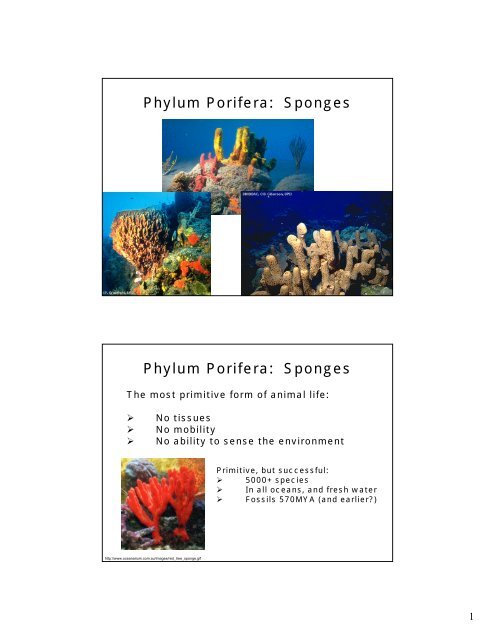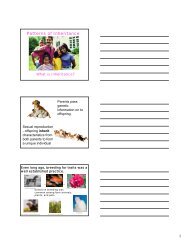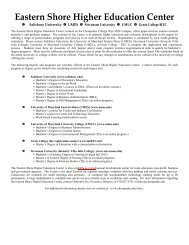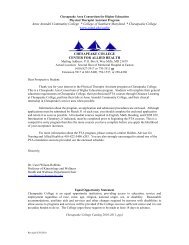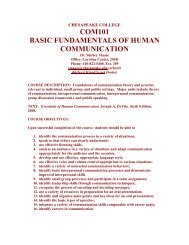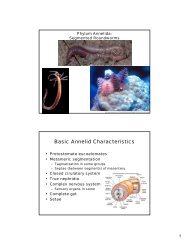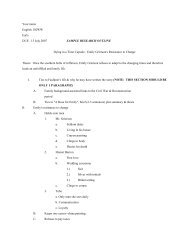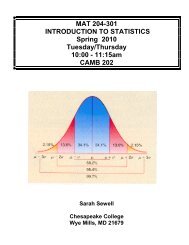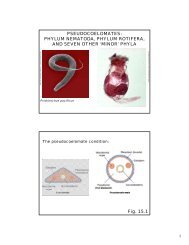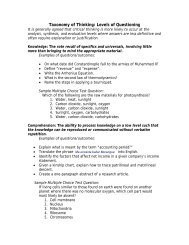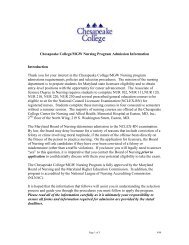Phylum Porifera: Sponges Phylum Porifera: Sponges
Phylum Porifera: Sponges Phylum Porifera: Sponges
Phylum Porifera: Sponges Phylum Porifera: Sponges
Create successful ePaper yourself
Turn your PDF publications into a flip-book with our unique Google optimized e-Paper software.
<strong>Phylum</strong> <strong>Porifera</strong>: <strong>Sponges</strong><br />
<strong>Phylum</strong> <strong>Porifera</strong>: <strong>Sponges</strong><br />
The most primitive form of animal life:<br />
‣ No tissues<br />
‣ No mobility<br />
‣ No ability to sense the environment<br />
Primitive, but successful:<br />
‣ 5000+ species<br />
‣ In all oceans, and fresh water<br />
‣ Fossils 570MYA (and earlier?)<br />
http://www.oceanarium.com.au/images/red_tree_sponge.gif<br />
1
<strong>Phylum</strong> <strong>Porifera</strong>: <strong>Sponges</strong><br />
No tissues: cellular grade of organization<br />
Filter-feeders<br />
Sessile (=not mobile)<br />
Often vividly colored<br />
http://www.westworld.com/~fabio/gallery/bonaire-scuba-photo/bonaire-purple-tu<br />
<strong>Phylum</strong> <strong>Porifera</strong>: <strong>Sponges</strong><br />
Cellular grade of organization:<br />
all functions carried out at the<br />
cellular level.<br />
Diagnostic cell type:<br />
choanocyte: a flagellated cell<br />
with a collar of microvilli<br />
2
Flagellum<br />
Choanocyte structure<br />
Cell body<br />
Collar<br />
(microvilli:<br />
extensions of<br />
the cell<br />
membrane)<br />
Choanocyte function<br />
Flagellum<br />
moves water<br />
through the<br />
collar<br />
Cell body<br />
ingests food via<br />
phagocytosis<br />
and passes it to<br />
archaeocytes<br />
for digestion<br />
Collar<br />
catches food<br />
particles from<br />
water (0.1μm<br />
to 50μm)<br />
High water flow<br />
also serves<br />
respiratory and<br />
excretory needs<br />
3
Choanocytes in situ<br />
Archaeocytes:<br />
amoeboid cells<br />
(totipotent)<br />
Sponge structure<br />
spicules (not a cell):<br />
calcium carbonate or<br />
silicon dioxide spines,<br />
for defense & structure<br />
porocyte: barrelshaped<br />
cell<br />
pinacocyte: flattened<br />
cell on exterior of<br />
sponge<br />
mesohyl: the<br />
acellular ‘goo’<br />
between cells<br />
4
Spicules: CaCO 3 or SiO 2<br />
Spongin:<br />
a protein<br />
<strong>Phylum</strong> <strong>Porifera</strong>: <strong>Sponges</strong><br />
Other cell types:<br />
Archaeocytes: a general name for amoeboid cells<br />
that carry out:<br />
digestion (and phagocytosis)<br />
spongocytes: secrete spongin<br />
sclerocytes: secrete spicules<br />
collencytes: secrete collagen (a protein)<br />
lophocytes: secrete lots of collagen<br />
Archaeocytes are totipotent: they can become<br />
any other type of cell in the sponge<br />
5
Sponge body plans<br />
Simplest form: ASCONOID<br />
(not a taxonomic name):<br />
small, with pinacocytes on<br />
the outside and<br />
choanocytes on the inside;<br />
single chamber<br />
water flow: IN<br />
through an ostium<br />
(=hole in porocyte),<br />
into spongocoel, OUT<br />
via osculum<br />
Sponge body plans<br />
More complex form:<br />
SYCONOID (not a taxon):<br />
larger; looks like multiple<br />
asconoid sponges stacked<br />
together<br />
Fig. 12-5, p. 238<br />
water flow:<br />
IN through an ostium,<br />
into an incurrent canal,<br />
through a prosopyle,<br />
into a radial canal,<br />
through an apopyle,<br />
into spongocoel,<br />
OUT via osculum<br />
6
Syconoid body plan<br />
water flow:<br />
IN through an ostium, into an incurrent canal, through a<br />
prosopyle, into a radial canal, through an apopyle, into<br />
spongocoel, OUT via osculum<br />
Sponge body plans<br />
Most complex form: LEUCONOID (not a taxon):<br />
larger; choanocytes in chambers within sponge<br />
water flow:<br />
IN through an ostium,<br />
into an incurrent canal,<br />
into a flagellated chamber,<br />
into an excurrent canal,<br />
into spongocoel<br />
(often reduced),<br />
OUT via osculum<br />
7
Leuconoid<br />
body plan<br />
water flow:<br />
IN through an ostium, into an incurrent canal, into a flagellated<br />
chamber, into an excurrent canal, into spongocoel (often<br />
reduced), OUT via osculum<br />
Reproduction and Development in <strong>Porifera</strong><br />
8
Reproduction and<br />
Development in<br />
<strong>Porifera</strong><br />
Gemmules: sexual dispersive/resistant phase<br />
(freshwater sponges)<br />
9


